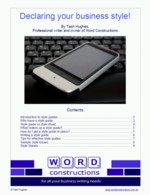What is a review?
Looking through some blogs recently, I have discovered some unusual interpretations of what a review is…
The online Oxford Dictionarydefines it as a formal assessment of something; a critical appraisal of a work; or a report after the event.
It seems simple – a review is a report about a book, course, website, blog or whatever to help others decide if the work is of potential use/interest/value to them. A review is not an ad (“this product has these features and is available only from us”) or a list of facts (“this website has 10 pages about getting fit”).
If you are writing a review, the following points may help:
- include all relevant details so someone can find the item easily if they want to. This includes the author and publisher for a book, product name and supplier/manufacturer for a product, name and URL for a website or blog, and so on
- give a summary of the item so the reader understands what you are reviewing, but don’t try to include everything – remember, no one wants to hear the punchline before the joke.
- be honest – that doesn’t mean only list bad things or be nasty, but don’t say it is wonderful if it has some faults or problems. If I write a negative review, I always try to include something positive as well
- give an assessment, such as ‘thoroughly recommend this book’, ‘great value for money’ or ‘not as good as their previous model’. This helps the reader decide whether they want to know more or not.
- qualify the work if required. For instance, a book or movie review may state ‘entertaining for the under 10s but tedious for adults’ or ‘thought-provoking but not suitable for teenagers’ so parents can choose not to allow children to read/see it
- be impartial or upfront about any connections as this builds trust and your credibility – a rave review about something you profit from may damage your reputation
Reviews are a great way to give value to others, but only if people can trust you to give honest, genuine reviews.
Happy writing!

 A style guide is simply a set of rules as to how your business produces it’s communication materials (including website content, letters, emails, marketing documents and promotional articles.)
A style guide is simply a set of rules as to how your business produces it’s communication materials (including website content, letters, emails, marketing documents and promotional articles.)
Recent Comments